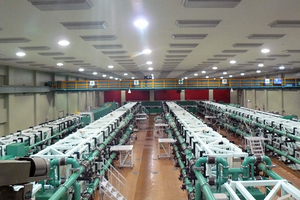World's most powerful laser: Why it's not the next Death Star
Japanese scientists say they’ve fired a beam equivalent to 1,000 times the world’s electricity consumption.

The GEKKO XII laser at the Osaka University's Institute for Laser Engineering.
Sho Kasuga, Creative Commons Share Alike
We’ve seen laser beams do some incredible things. From pioneering the interactive hologram, to holding microscopic objects too delicate for human hands, to improving our eyesight, the possibilities of the laser seem endless.
This week, Japanese scientists have upped the ante once again, as they confirm they’ve fired the most powerful laser beam in the world.
Researchers at Osaka University’s Institute of Laser Engineering have produced a beam that concentrates the equivalent of 1,000 times the world’s electricity consumption, reported the Asahi Shimbun.
The giant laser is named LFEX, or Laser for Fast Ignition Experiments, and measures a staggering 300 feet long.
The Japanese team was “able to generate so much power so quickly thanks to a series of glass ‘lamps’ that amplified the laser as it passed through them,” reported Engadget.
The laser beam of two petawatts (two quadrillion watts) lasted just one picosecond, or a trillionth of a second. The incredibly short burst released enough power to run a microwave for about two seconds.
Until now, the world has only seen a laser produce half that amount of power – from a 1-petawatt laser housed at the University of Texas at Austin.
Osaka University scientists claim that their pulse (2 petawatts at 1 picosecond) is about 100 times the energy of UT Austin’s laser, and twice its peak power, according to The Daily Mail.
“Naturally, the announcement was immediately met with comparisons to the Death Star,” wrote Defense One’s Patrick Tucker.
But Michael Donovan, associate director of the Texas Petawatt Laser project, says these comparisons are misguided.
Firstly, since power is energy over time, it’s important to remember that the amount of energy used is actually very little, he told Popular Science. “The energy of the Texas Petawatt, 150 to 200 Joules, is about that in a cup of coffee or a very hard tennis serve.”
Secondly, while the magnitude of the LFEX is impressive, it’s not likely to introduce new military capabilities, added Dr. Donovan.
Because petawatt lasers ionize the air they come in contact with, they only work in a vacuum, he explained to Defense One.
“If one wanted to destroy a satellite, the Japanese LFEX laser would not be the answer, as it would not propagate far through the atmosphere – even if it could be pointed towards the satellite,” he said.
But the Osaka team’s priorities lie elsewhere.
“With heated competition in the world to improve the performance of lasers, our goal now is to increase our output to 10 petawatts,” the institute's Junji Kawanaka, an associate professor of electrical engineering, said in a statement.


